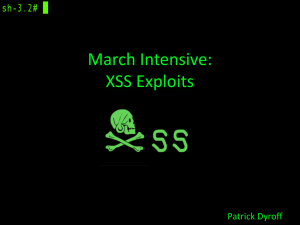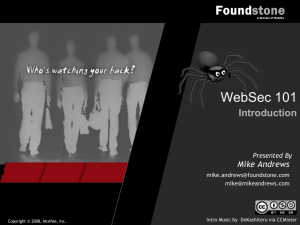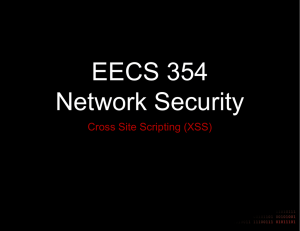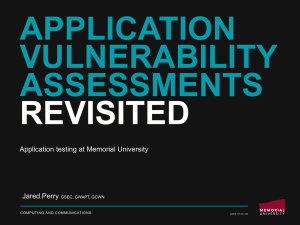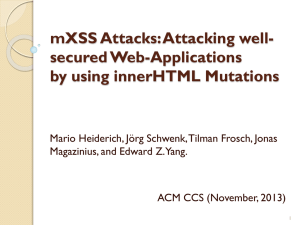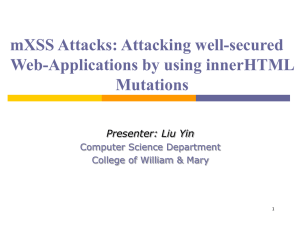Slides
advertisement
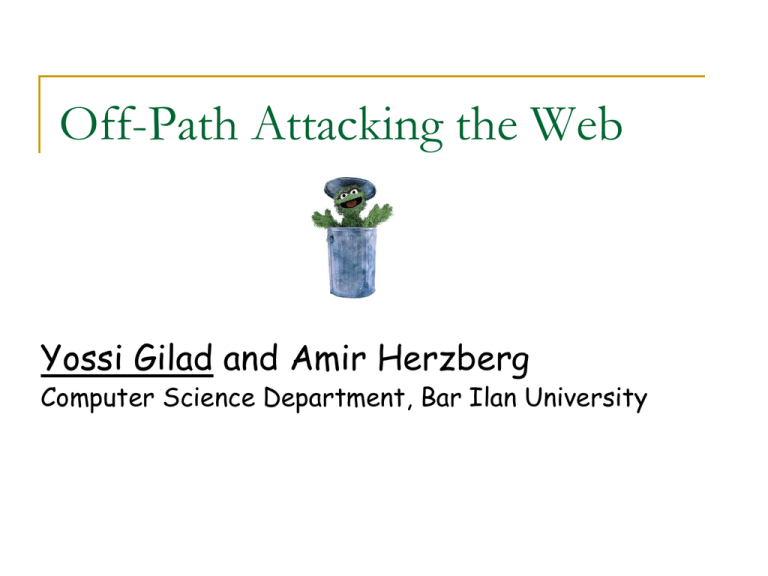
Off-Path Attacking the Web Yossi Gilad and Amir Herzberg Computer Science Department, Bar Ilan University Oscar: the Off-Path Attacker Bob, I leave you! Alice 4.4.4 1.1.1 6.6.6 2.2.2 Bob, I love you! Alice 5.5.5 3.3.3 Why Off-Path Attacks? Why not MitM (Eavesdropper)? Can Oscar spoof IP packets? Harder: physical access or control router Often not: most ISPs ingress-filter But enough ISPs don’t (18%-22%) What of challenge-response Defense? Correct use of challenge-response suffices But: Often, challenge-response used incorrectly Since used for other purposes, e.g., in TCP for SEQ/ACK This work: Off-Path TCP Injection Allows XSS, phishing and more… Related Work Predictable ISNs: Morris85, Mitnick95, Zalewski01,05 `PoC’ for Windows clients: klm07 Address-based client authentication vulnerable [Bellovin89] We improve (FW, efficiency), extend to exploit QianMao12, QMXie12: (limited) malware QM12: Also assumes seq#-checking-fw Does not work for Windows clients Attack Scenario and Goal 1. 2. 3. 4. Alice surfs to Oscar’s site Alice’s browser runs Oscar’s script (puppet) Puppet sends HTTP requests to Bob Oscar injects response into the connection between Alice and Bob (est. by the puppet) 3. Script opens (hidden) frame of Bob.com Internet 1. Surf to Oscar.com 4. Inject (e.g., script) as content from Bob 2. Send page with script Attack Goal and Scenario Alice’s browser assigns Oscar’s spoofed response with context of `Bob’ Can contain script: cross site scripting (XSS) Request objects: cross site request forgery (CSRF) Spoof a web-page, response may be cached What Do We Need? Grocery List Task #1: identify the `victim-connection’ between Alice and Bob Task #2: learn sequence numbers Spoofed data needs to correspond with a real connection TCP discards packets with invalid seq # Task #3: exploit Send (spoofed) data in correct HTTP context Browser assigns data the credentials of server (Bob) Attack and Talk Overview Learn connection identifiers (IPs:ports) Learn server’s sequence number Learn client’s sequence number Exploit(s): XSS CSRF Phishing Conclusions Identify Victim-Connection A TCP connection has four Identifiers: <ServerIP:port, ClientIP:port> Puppet opens connection to Bob (server) ServerIP:port selected by puppet (attacker) Client IP: known from client connection to Oscar Client port: sequentially assigned… Not sequential? See [GH PETS’12] [Windows] Finding Server Sequence Number TCP sequence numbers are 32-bits Need to learn the sequence #. How? that’s too long to guess Use TCP responses to probe packets Empty-ACK packets provide useful response: If seq# out of WIN: send ACK to re-sync If seq# is in WIN: no response to avoid `ACK storm’ Finding Server Sequence Number How to detect if response is sent? IP-ID: 16 bit identifier in IP header Use IP-ID side channel Used to correctly reconstruct packet from fragments In Windows: implemented as a global-counter One connection (to Oscar) leaks info about another! Old trick: NMAP’s idle-scan, Bellovin machine-count,… Finding Server Sequence Number Puppet opens connection to server Oscar sends query-probe-query: 1. 2. Query: unordered 1-byte packets ACK (ipid) Probe (srcIP = server): empty-ACK with seq# =i∙w 1. 2. w is estimate of WIN size Found binary search finds exact seq# Attack and Talk Overview Learn connection identifiers (IPs:ports) Learn server’s sequence number Learn client’s sequence number Exploit(s): XSS CSRF Phishing Conclusions Finding Client Sequence Number Already know server seq# (and IPs, ports) This should have been enough to inject (according to TCP spec) But Windows implementations (as of XP SP2) also validate the ack number of packets The valid ack# is the client’s seq# Finding Client Sequence Number To find client seq#: send pkt w/ data For Windows clients: With server’s IP:port, correct seq# TCP’s handling depends on ack# Silently discards pkt with `old` ack number Otherwise: send ACK Leaks: ack#>UNA Binary search… Windows: silently discard RFC: Process (often, ack) UnAcked Process Discard and send duplicate Ack Next Attack and Talk Overview Learn connection identifiers (IPs:ports) Learn server’s sequence number Learn client’s sequence number Exploit(s): XSS CSRF Phishing Conclusions Exploiting Injections: XSS, CSRF Cross Site Scripting (XSS): cause browser to run MalScript in context of victim.com Typical XSS: exploit bug in site or browser Off-path-injected XSS: no need for vulnerable site/browser! Script can post fake HTTP requests (CSRF) Exploiting Injections: XSS, CSRF Cross Site Scripting (XSS): cause browser to run MalScript in context of victim.com Typical XSS: exploit bug in site or browser Off-path-injected XSS: no need for vulnerable site/browser! XSS Exploit: Results Top 1024 sites, 10Mb win clients, 1Mb Oscar Average 32 pkts/s `noise` Immune sites: mostly SSL or non-persistent Phishing by Injection Off-path XSS, CSRF may fail: Alternative: phish / deface ! Change contents: steal PWDs, push malware… Cache spoofed page To collect user-entered data, e.g., passwords Esp. if site uses SSL for passwords at local browser or network proxy User receives the spoofed page when he/she expects real page Phishing by Injection Off-path XSS, CSRF may fail: To collect user-entered data, e.g., passwords Esp. if site uses SSL for passwords Alternative: phish / deface ! Change contents: steal PWDs, push malware… Conclusions TCP may not be secure against off-path attackers! Use `real’ security: SSL/TLS, IPsec, etc Attacks may be improved, abused further… Thank You! Special thank you to CPIIS for supporting my research Questions?
